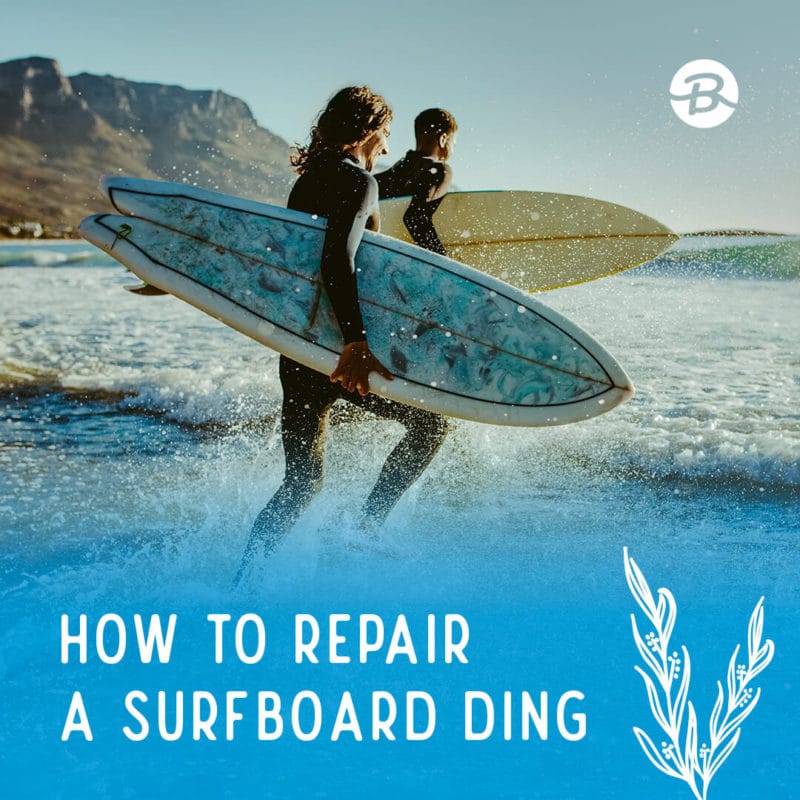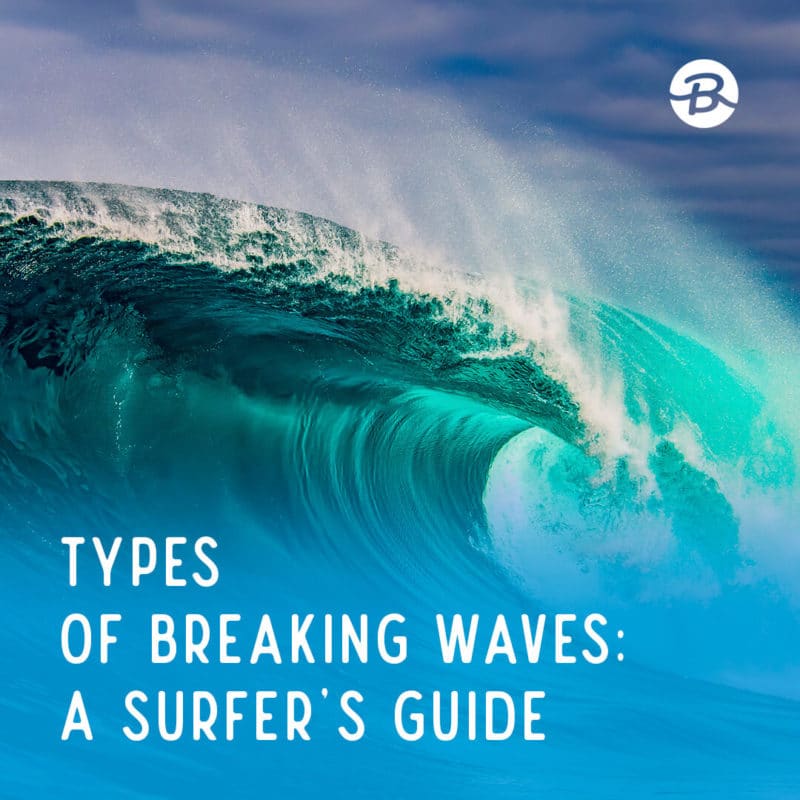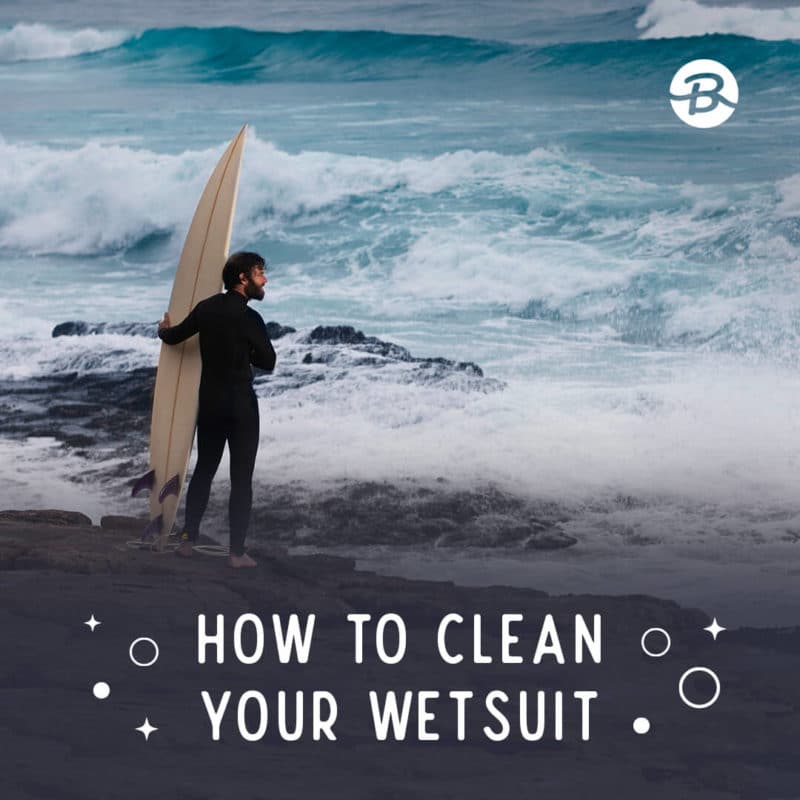Applying surf wax to your board seems easy enough, right? And, while it’s not too difficult, there is a method to applying wax the right way. If you’re trying to have a serious surf session, it’s important to know how to apply surf wax the right way. And we’re going to share simple steps and other important tips.

Although surfers have been waxing their boards for many years, there have been several changes in waxes. In fact, a long time ago surfers coated their boards with a sand-infused varnish. Now, there are various surf wax bars for different weathers, waters, and even some that can repel sharks.
Now, let’s take a look at everything you need to know about waxing your board so you can look like a surfing pro!
What Does Surf Wax Do?
A waxed board is essential if you want to enjoy your time on the board catching waves. It’s responsible for giving grip and traction to your feet while standing on your surfboard. It also stops your body from sliding down the board when you’re paddling. So, to properly surf and enjoy yourself on the waves, waxing is a must!
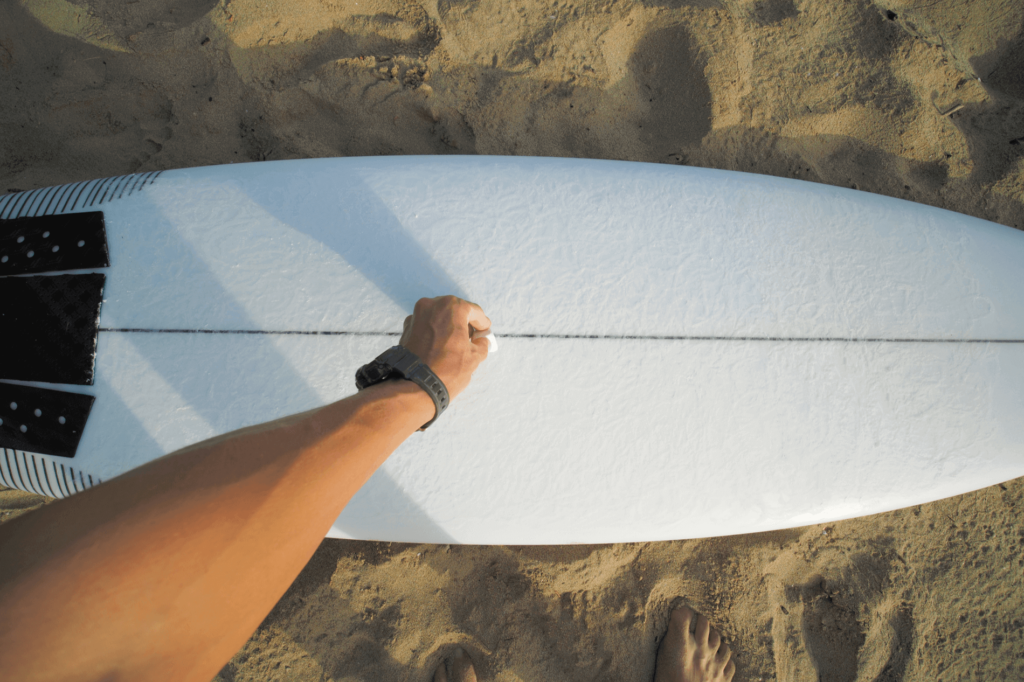
How Do You Wax a Surfboard?
When it comes to waxing your board, there are a few simple but essential steps.
1. Get all your supplies.
The perfect wax job requires specific materials including the right surf wax:
- a base wax: base coats are used for your surf wax to have something to to adhere to
- surf wax: choose one specifically for your water temp; most brands offer waxes for warm, tropical, cold, and cool water
- a wax comb: a special tool for maintaining and removing wax; makes grooves to improve traction and scrapes off remaining wax residue
- small towel: used to wipe your board after the wax is removed
- wax remover: needed to remove wax when it’s time for a refresh, which is important for maintaining your board
Pro Tip: The base of surf wax is paraffin. It’s also often mixed with beeswax and petroleum jelly. If you prefer a natural product, there are plenty of vegan and cruelty-free products like the popular Mr. Zog’s Sex Wax (check it out here).
2. Clean your board.
Every good wax job starts with a clean slate. To soften the wax for easier cleaning, you can leave your board out in the sun for about 10-15 minutes before cleaning. Rule of thumb: Try to make your board look as fresh and new as the day you got it.
Remove any old wax using your wax comb. Clean any excess wax with your wax remover until the deck is nice and glossy. You should also make sure all dings have been covered and repaired properly before applying new wax.
Cleaning tips:
- Once the wax is a little soft, scrape it using the scraper side of your wax comb or a credit card you don’t use anymore. Start from the tail and work your way to the nose or vice versa.
- When most of the wax has been removed, wipe your surfboard using your towel to get rid of any old surf wax. It should come off easily because it has melted off due to the sun’s heat.
3. Apply basecoat wax.
Now that your board is like new again, it’s time to apply your base coat so your surf wax sticks better. First, let your board cool down. Do not apply your base coat in direct sunlight since the heat could cause it to smear. One of the best tricks to make sure your base wax sticks to your board is to dip it in a bowl of iced water. But if you don’t have access to this, you can skip it.
If you want to make the most out of your base coat, it’s recommended to follow specific waxing patterns. Three of the most popular ones are the crisscross, little circles, and zigzag. Let’s take a look at what those are:
Crisscross Pattern
For an easy start, go with the crisscross pattern. This is ideal if you’re rushing to get out of the water.
- Hold your base coat at an angle so only the thinnest side touches the board.
- Using light pressure, draw long diagonal lines across the deck of your board a couple of inches apart from each other. If you’re using a shortboard, start at the spot where you will be standing and where you place your hands when you pop up. If you have a longboard, make diagonal lines throughout the entire deck. For beginner surfers who haven’t mastered cross-stepping, there’s no need to wax all the way up to the nose. Just apply it in the zone where you’ll be positioning your chest while paddling, with a little extra coverage.
Circle Pattern
The circle method takes a little longer but gives a more consistent pattern with your wax bumps.
- Hold your wax with the thin side touching the board.
- Very lightly run it on your board in small circular motions. This is just the base coat, so no need to go hard and make the layer too thick. Continue making the circular motion until your desired area is covered.
- Continue applying until you’ve covered the deck on the areas where your feet and hands when you pop-up will go.
Zigzag Pattern
In this video, Longboard champion Kelia Moniz demonstrated how she waxes her board using a zigzag pattern.
- She holds her surfboard wax at an angle and starts drawing evenly spaced zigzags on her board from the tail towards the nose.
- Then, she repeats the process for a second time while drawing the zigzag pattern from rail to rail. This creates equally spaced lines and smaller areas without wax, making the topcoat application easier.
Remember that the waxing pattern you use is entirely up to your personal preference. Regardless, the goal is to make sticky bumps that provide traction. You can do a mix of any of the patterns mentioned above or make your own. The one thing all surfers need to know when it comes time to wax a surfboard is that the wax needs to be applied gently. If you press down too hard, the wax will smear.
4. Apply the top coat.
After getting your base wax in order, don’t run to the water just yet. You still need to apply your top coat which is the one specified for particular water temps. While you shouldn’t use warm wax in cold water, it’s okay to use cold wax in warm water if that’s what you have. But, more on choosing the right one in a bit!
White-colored waxes are most common, but if you want to see the distinction between your base coat and topcoat, you can pick a topcoat that has a different color than your base coat.
Regardless of which waxing pattern you used for your basecoat wax, your topcoat is meant to be applied horizontally, vertically, or in small circles. Again, this step aims to form small bumps to give you traction, and the more, the better.
This can be accomplished using moderate pressure and an even waxing motion. If there are pressure dings in your board, use the corner of your wax to fill the area.
As a general rule, use around twice as much surf wax on your top coat compared to your base coat. Once your board is covered, you can finally start ripping in the water.
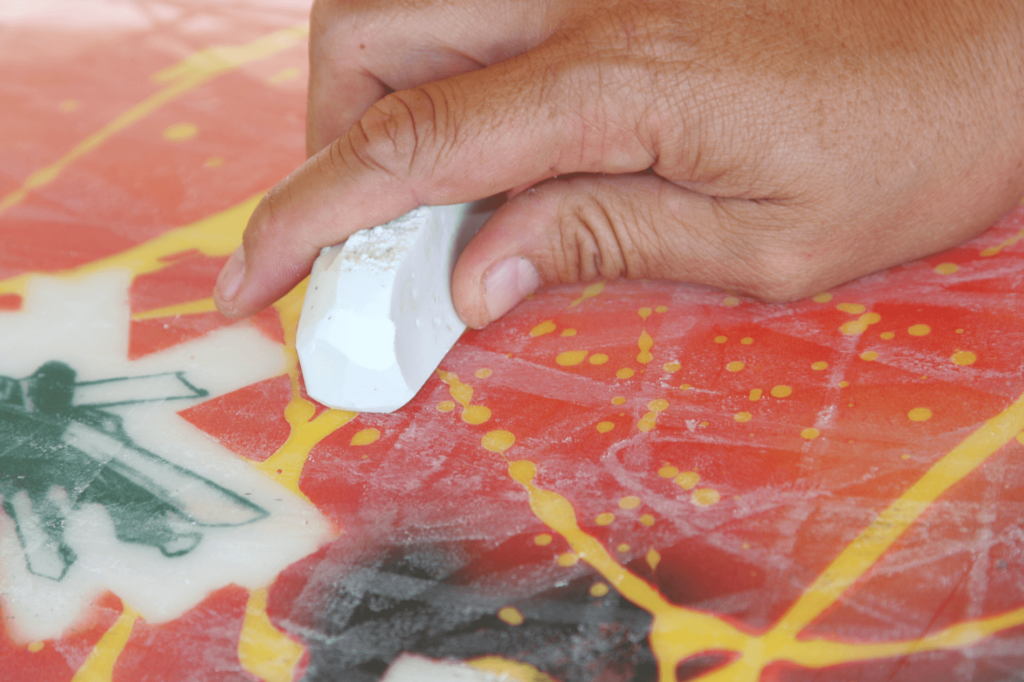
Frequently Asked Questions
Make sure you know everything there is to know about how to wax a surfboard by checking out these common questions!
How often should I wax my surfboard?
Ideally, you’ll add a thin layer of fresh wax every time you hit the waves. Once all the wax has built up over time, you’ll use your wax comb to expose some of the old wax and create a pattern to give you the right grip. And, if you happen to find yourself needing some extra grip and you don’t have a comb on hand, a handful of wet sand can do the job.
Does temperature affect how often you change your wax?
Absolutely! How often you change your wax largely depends on the water temperature.
If you’re enjoying one of the world’s best surfing spots in the hollow barrels of Siargao, Philippines, you’ll notice that your wax more easily melts and wears off due to the heat. When that happens, you’ll inevitably need to reapply wax often.
However, if you longboard in Malibu in the winter months, the wax lasts longer. This is where wax combs come in handy. Use your comb to add grip when needed and reapply wax in areas where the top coat has flaked off.
What will happen if you don’t change your surf wax?
If you don’t change your surf wax, your board might look like a mess. And, even worse, you’ll have trouble looking like you know what you’re doing out there because you won’t have the appropriate grip.
Because wax oxidizes, it loses its traction ability over time. Before you think this isn’t a huge deal, any seasoned surfer will warn you about the dangers of a slippery board. When you don’t have a good grip on your board, there’s a good chance of falling off and causing injury. It can even endanger other people if you’re surfing in a crowded spot. And, you don’t want to be that person!
When should I remove old wax?
The answer to this question is subjective. Many surfers, especially those who do it professionally, love riding a board with a fresh coat of wax. On the other hand, some surfers don’t care about how their surf wax looks or how old it is.
If you consistently surf, you may need to clean your board once every month or two. However, surfers who only hit the waves on the weekends can usually wait until the season changes. If you do a quick rewax and comb touch-up each time you go out for a session, this should do the trick.
If you’re taking an extended break from surfing, it’s vital to remove all old wax before storing your board. You can also do this when you’re traveling with your board. This will ensure your surfboard wax doesn’t melt inside your board bag while you’re en route to your destination.
When it’s time for wax removal, surfers love using the Pickle Wax Remover, like this.
What are the most popular surf wax brands?
Choosing the best surfboard wax is important and takes some thought. Thankfully, surf wax is very inexpensive, so you don’t have to burn money to try different brands.
To make sure you get the real deal, these are some good ones to try:
- Mr. Zog’s Original Sex Wax
- Matuna’s Surf Wax
- Surf Organic
- FK Gold Wax
- Kassia Palo Santo Surf Wax
- Palmer’s Tropical Surfboard Wax
- Fu Wax
- Bubble Gum Surf Wax
- Sticky Bumps Original Surfboard Wax
If there’s a surf wax maker in your local surf area, make sure to check out their products as well when it’s time to buy wax. Independent wax makers usually have more wholesome ingredients.
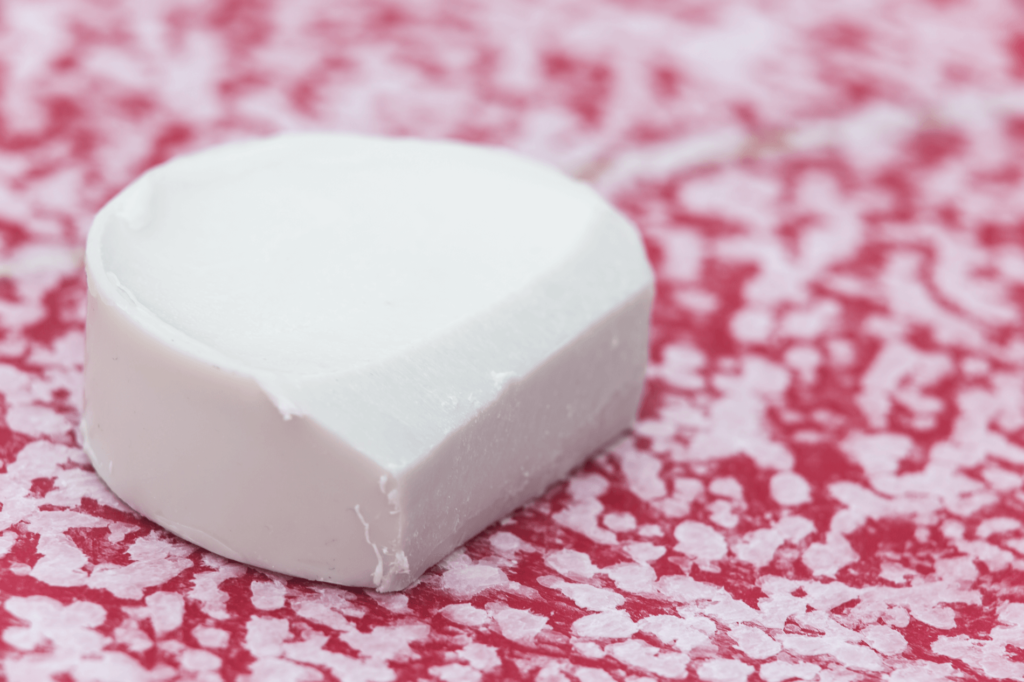
What kind of wax should I use on my surfboard?
With so many brands and types of waxes, you might be wondering how to choose the right one for you. As we mentioned, water temperature plays an essential role in picking the right surf wax. Typically, you’ll see cold, cool, warm, and tropical wax. Let’s take a look at each one to help you decide what you need to wax your board:
- Cold wax: Cold water wax is the softest wax you can find and it’s used in waters that are below 14 degrees Celsius or 58 degrees Fahrenheit. Because it’s so soft, it’s easier to apply.
- Cool wax: You’ll use this soft wax if you’re surfing in cool water that’s 12 to 20 degrees Celsius or 54 to 69 degrees Fahrenheit.
- Warm wax: This is a harder wax for warm water that ranges from 17 to 25 degrees Celsius or 63 to 78 degrees Fahrenheit.
- Tropical wax: If you’re in a tropical paradise, this is for you! It’s a hard, extra sticky wax that’s designed for waters above 24 degrees Celsius or 74 degrees Fahrenheit.
If you surf in different water temperatures, you may want to grab a few different waxes to have on hand.
How can you take care of your surfboard and wax?
If your surfboard is special to you (I’m sure it is!), you want to take care of it. Waxing it is a huge part of keeping it looking nice, and, of course, helping you look like a pro out there on the waves. Here’s how you can take ultimate care of your surfboard and wax.
- Don’t leave your board or surf wax in direct sunlight. The wax can melt and the board can dry out and become cracked.
- After a session, take the serrated side of your wax comb across your board’s deck. This will maintain the texture of your wax.
- When you’re finished catching waves, rinse your board and let it dry. The salt can actually shorten your board’s lifespan.
- Transport the board properly on a board rack. If you’re carrying multiple boards, place some kind of cloth between them, so the wax doesn’t stick.
- Fix dings asap. Board damage can get worse if you don’t fix it. Until you’re able to head to a repair shop, you can sand the area, apply solar resin, then sand again once it’s dry.
Do you need to wax foam boards?
Yes and no. You don’t have to, but you may as well. To make sure you have extra grip, it’s never a bad idea to apply some surf wax to your foam board. While foam boards aren’t slick when they’re dry and most have texturized decks, they do feel more slippery once they get wet and extra traction will only help on the water.
Are skimboard and surfboard waxing the same?
Pretty much! A lot of people who love surfing are also interested in other board sports. If you’re also into skimboarding, it makes perfect sense to wonder if skimboard and surfboard waxing are the same.
If you already know how to apply wax to your surfboard, it means you can apply wax on your skimboard, too. For both wax jobs, you need to choose the right wax depending on the temperature, apply a base coat, and finish off with a topcoat. The idea is to make sticky bumps that give a good grip no matter what board you’re using.
Reapply a thin coat each time you hit the water and clean and re-wax when needed. You’ll also use a traction pad for your skimboard for maximum grip.
Do I need a traction pad for my surfboard?
No, you don’t have to have one. It’s recommended to use a traction pad for a shortboard to improve arch. They’re not necessarily fun to put on but will usually last as long as your board does. For mid-length boards and longboards, there’s no need to worry with a traction pad.
Final Thoughts
Now that you know how to apply surf wax like a pro, we hope you’re feeling confident in this essential pre-surf ritual. It may take a few sessions to get the hang of waxing your board. But after a few times, you’ll have the method down, and it’ll take no time.
Although waxing your board might feel like a chore, it’s well worth taking a few extra minutes to do it if you want to look like you know what you’re doing and enjoy your time on the water. While you wax your board, you can catch up with friends, check out the beach conditions, and examine for dings. Before you know it, you’ll be ready to hit the waves!


